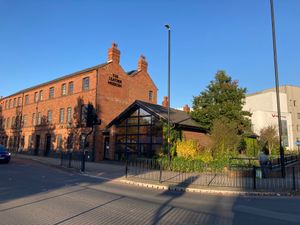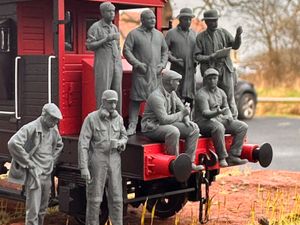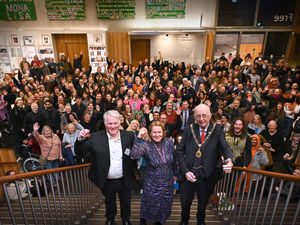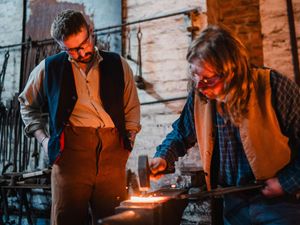Wolverhampton signwriter wows with barge decorations
It could be said that canals are in artist Meg Gregory's blood. She works as a traditional signwriter, which includes hand-painting the beautiful and decorative script found along the side of narrow boats.

But the 42-year-old didn't discover her family's own connection to the waterways until after she had been living on a boat for 10 years.
Since starting her art journey, Meg who lives in Wolverhampton, has found out that her great-grandmother Evelyn Kite also played a part in the area's canal heritage.
"My great nana, Evelyn Kite, ran the coal yard and wharf at Wightwick from 1947 to 1960.
"Her husband and son, both called Percy, helped and used to collect a boatload of coal about once a month from Littleton Colliery Basin near Penkridge and bring it back to the wharf to sell on from there.
"The boat was called Mildred and their horse that used to pull the boat was called Paddy," explains Meg.
Now her husband David's family own a wharf at Bridge 53 on the Staffordshire and Worcestershire Canal at Dimmingsdale, Lower Penn, where her work is based.
After studying art and design at Stourbridge College of Art, she went on to complete a degree in historic decorative craft at Lincoln College of Art in 1999.
"I was looking for a more practical use for my art. I didn't want to do fine art or sculpture, I knew I wasn't good enough for that and I couldn't see myself making a living from it. But I had always been interested in historic crafts and old buildings," explains Meg.
After finishing her degree, she began working as a general signwriter and started her business Scribe Signwriting.
Having lived on a boat since college days, she became interested in the folk art associated with working boats and the inland waterways.
Many people will recognise the Castle and Roses designs traditionally used to decorate vessels.
They were used to cover everything from water cans and cabin stools to doors, bringing a splash of colour and creativity to the boats.
Although both castles and roses feature in the artwork, there are often a number of other flowers as well as scenic scenes with cottages, churches, rivers and lakes.
Boat owners took pride in their vessels and it was a way of making them stand out during their journeys along the waterways. Often the name of the boat was also included in the designs.
"Working boats had a hard life so it was a way of making them look nice. They didn't have much room on their boats so everything they did have needed to be useful too.
"Sadly, this also means there are not many examples left because they've either fallen in the cut or been broken through use," Meg tells us.
Eager to learn more, in 2007, the mother of two took up an apprenticeship for boat signwriting and decoration with Phil Speight at Craftmaster Services in Stourbridge.
"I learned a lot from Phil and was really able to hone skills. One of the most important things I learned was how to turn up at a job and start painting the boat on the same day.
"Previously I would have gone there and measured up and planned it all out before I started painting.
"But I learned from Phil that as long as I know my letter forms, I know what will fit in the space and that enables me to get started straight away," she added.
Since completing her apprenticeship in 2009, she returned to running her own business full time in 2010.
But her work is not just limited to boats as she is also called upon for other projects from fairground lorries and ice cream vans to steam engines and even gravestones.
"It's great because my work is often the last thing to be done on someone's project so I get to see what people have been busy restoring in their sheds," says Meg who is mother to five-year-old Ivan and two-year-old Carla.
When starting a new sign, she begins by measuring the panel she is going to paint. "I see how many letters I need to fit in and divide the space up so I know how big they need to be,"she says.
Next, using a chinagraph pencil or chalk, she draws the outline of the letters and design on to the panel.
Before painting she ensures her sable brushes are clean before 'loading' one with signwriting enamel paint, which she has already decanted from the tin into a smaller pot.
"It's important to work the brush up and down on a tile so that the bristles are all covered and there is an even amount of paint because this will help ensure there is a nice, flowing line," says Meg, who uses a mahl stick to rest her working hand on as she paints the lettering.
The first coat of paint is left to dry overnight before a second layer is added. "It's very satisfying to see the finished job," says Meg, who is also the main signwriter for Traditional Painting Services, run by John Sanderson at Dadfords Wharf, Wordsley near Stourbridge.
One factor Meg has to take into account when painting a boat is that it may well be moving when it's still on the water.
"In one wharf, the water levels change a lot so not only is the boat moving from side to side, it moves up and down too.
"The fact that it's moving does make it a bit more of a challenge but you get used to it," she tells us.
For Meg, signwriting is not just art, it's a link to our past and is keeping a traditional craft alive for future generations.
"It's beautiful and it serves a purpose. I also Iove it because people have been doing it for centuries and it's keeping alive a traditional art that had almost died out in the 1980s.
"Vinyl lettering and computer-created lettering became popular because they could be done in less time but they didn't have the same character as traditional painted signs.
"But now more people are wanting traditional sign-writing, how it was done 50 years ago, because they appreciate the art and the time it takes. There are still a few of us doing it too, which is brilliant," she says.





